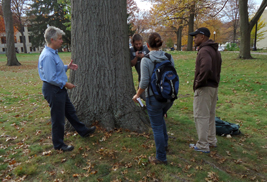Featured Article
2013 Outstanding Teaching Award Nominees
Every year, the University Teaching Council recognizes Kent State’s outstanding full-time, nontenure-track and part-time faculty members by awarding three educators with the Outstanding Teaching Awards.
read moreKent State Urban Forestry Students Place Monetary Value on Campus Trees
Posted Oct. 7, 2013 | Emily Komorowski
Heather White (left), manager of University Facilities
Management at Kent State, trains students on how to take
inventory of urban trees on the Kent Campus.
Two Kent State University students from the new Urban Forestry class presented findings on Kent State’s tree inventory at various professional conferences in Ohio and Nevada this year.
The year-old course, taught by Dan Ross, instructor at Kent State’s departments of Geography and Biology, focuses on the study of trees in the urban environment. The U.S. Department of Agriculture Forest Service created a program called i-Tree to put a monetary value on the uses of urban forests, says Ross.
“Heather White, who is the manager of university facilities, came to me because Kent State has always been recognized as a Tree Campus,” says Ross, referring to the Tree Campus USA status the university receives annually from the Arbor Day Foundation. “Part of the Tree Campus program is to not only take care of the urban trees, but also to expand. Part of this expansion would be to offer a course in urban forestry.”
For the course, 13 students tested 270 trees in the area between Hilltop Drive and Main Street on the Kent Campus, using the i-Tree software.
The students determined how to put value on urban trees based on energy, carbon dioxide, air quality, storm water and aesthetics. They found that the annual value of the 270 trees was $44,094.
This led to both oral and poster presentations at five professional conferences.
“The presentations overall got very good feedback at conferences,” says Ross. “Before i-Tree came out, there was no way to put a value of water quality to your urban trees, so therefore this topic gets a lot of interest.”
Stephanie Deibel, senior conservation major, is one of the two students in the class who presented at the Ohio Storm Water Conference in Cincinnati.
“The most exciting part for me was being able to put the monetary value on the trees,” Deibel says. “It is kind of crazy how different species will take in more or less carbon or water. I never really considered that before.”
The course is also currently being offered this semester, and students will be given a chance to present their work this October at the 2013 National Nonprofit Source Monitoring Conference and Workshops in Cleveland.
“The students performed well beyond how I expected them to for their first year,” says Ross. “Watching them grow as students was the most exciting part of this course for me.”
For more information about the Urban Forestry course, contact Ross at daross@kent.edu.